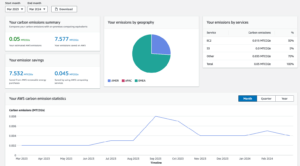The carbon footprint of AWS and TC2’s clients – 2024 update
We published an article back in Spring, 2023 about the carbon footprint of TC2’s Customers using the AWS customer carbon footprint tool. It’s time to check the current situation (i.e. the annual figures for the period between March 2023 and March 2024).
Just a short recap: the AWS customer carbon footprint tool is a tool provided by Amazon Web Services (AWS) that helps customers estimate and understand the environmental impact of their usage of AWS services. In simple terms, it shows the amount of carbon dioxide (CO2) emissions associated with running their applications and services on the AWS infrastructure.
By implementing different strategies from Energy Efficiency, Renewable Energy, Sustainable Practices to Efficient Resource Utilization, AWS not only reduces its own environmental impact but also helps its customers lower their carbon footprints.
By utilizing the AWS customer carbon footprint tool, customers can adopt more sustainable practices and help reduce the environmental impact of their cloud infrastructure.
Let’s take a look at the carbon footprint of TC2 Customers using the AWS customer carbon footprint tool:

The graph above displays the estimated AWS emissions alongside the projected emissions savings compared to running the same workload on-premises. For TC2 customers, this saving is 7,577 metric tonnes of carbon dioxide equivalent (MTCO2e) between March 2023 and March 2024.
This can be further divided into two categories:
1. emissions savings from the efficiency of the AWS cloud infrastructure: 0,045 MTCO2e
2. emission savings from the purchase of renewable energy from AWS: 7,532 MTCO2e
In addition to the geographic breakdown, we can also see the carbon emissions from using Amazon Elastic Compute Cloud (EC2), Amazon Simple Storage Service (S3) and other AWS products or services.
“In general, AWS infrastructure is up to 4.1 times more energy efficient than on-premises and can reduce workloads’ carbon footprint by up to 99%.
3.9 billion liters of water are returned to communities each year from replenishment projects completed or underway.
100% of electricity consumed by Amazon was matched with renewable energy sources in 2023” – -according to AWS
AWS also has several ambitious plans and initiatives for sustainability in the future:
100% Renewable Energy by 2025: AWS has set a goal to power its global infrastructure with 100% renewable energy by 2025. This involves significant investments in wind and solar projects worldwide.
The Climate Pledge: Amazon, AWS’s parent company, co-founded The Climate Pledge, committing to achieving net-zero carbon across its operations by 2040, ten years ahead of the Paris Agreement. This pledge includes measures to regularly report greenhouse gas emissions, implement decarbonization strategies, and neutralize remaining emissions.
Carbon Zero by 2040: As part of The Climate Pledge, AWS is working towards reaching net-zero carbon emissions by 2040. This involves reducing emissions across its operations and investing in nature-based solutions.
Sustainable Data Centers: AWS is continuously innovating to build more sustainable data centers. This includes the use of energy-efficient technologies, such as custom-built servers and advanced cooling systems, and exploring alternative energy sources like hydrogen fuel cells.
Water Stewardship: AWS is committed to improving water efficiency in its data centers and supporting water-positive initiatives in the communities where they operate. This includes reusing and recycling water and supporting water restoration projects.
Circular Economy Initiatives: AWS is working to extend the lifecycle of its hardware through refurbishment and recycling programs. They aim to minimize waste by designing products for longevity and reusability.
Sustainability in Supply Chain: AWS is collaborating with suppliers to reduce their environmental impact. This includes encouraging suppliers to set their own sustainability goals and adopt renewable energy practices.
Customer Tools and Services: AWS provides tools such as the AWS Customer Carbon Footprint Tool to help customers measure, track, and reduce their carbon emissions. AWS also promotes best practices for building sustainable architectures through the AWS Well-Architected Framework.
Research and Development: AWS invests in research and development to find new ways to improve energy efficiency and sustainability. This includes exploring innovative technologies and solutions that can be applied to its infrastructure and operations.
By pursuing these initiatives, AWS aims to significantly reduce its environmental impact and help its customers achieve their own sustainability goals.
